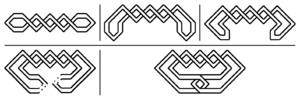Twist knot

In knot theory, a branch of mathematics, a twist knot is a knot obtained by repeatedly twisting a closed loop and then linking the ends together. (That is, a twist knot is any Whitehead double of an unknot.) The twist knots are an infinite family of knots, and are considered the simplest type of knots after the torus knots.
Construction
A twist knot is obtained by linking together the two ends of a twisted loop. Any number of half-twists may be introduced into the loop before linking, resulting in an infinite family of possibilities. The following figures show the first few twist knots:
 One half-twist
One half-twist
(trefoil knot) Two half-twists
Two half-twists
(figure-eight knot) Three half-twists
Three half-twists
(52 knot) Four half-twists
Four half-twists
(stevedore knot) Five half-twists
Five half-twists
(72 knot) Six half-twists
Six half-twists
(81 knot)
Properties

All twist knots have unknotting number one, since the knot can be untied by unlinking the two ends. Every twist knot is also a 2-bridge knot.[1] Of the twist knots, only the unknot and the stevedore knot are slice knots.[2] A twist knot with half-twists has crossing number . All twist knots are invertible, but the only amphichiral twist knots are the unknot and the figure-eight knot.
Invariants
The invariants of a twist knot depend on the number of half-twists. The Alexander polynomial of a twist knot is given by the formula
and the Conway polynomial is
When is odd, the Jones polynomial is
and when is even, it is
References
- ↑ Rolfsen, Dale (2003). Knots and links. Providence, R.I: AMS Chelsea Pub. p. 114. ISBN 0-8218-3436-3.
- ↑ Weisstein, Eric W. "Twist Knot". MathWorld.